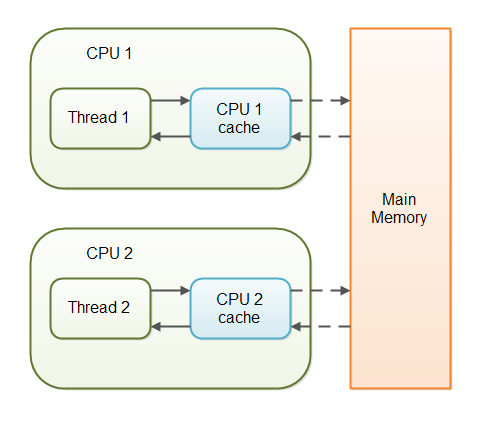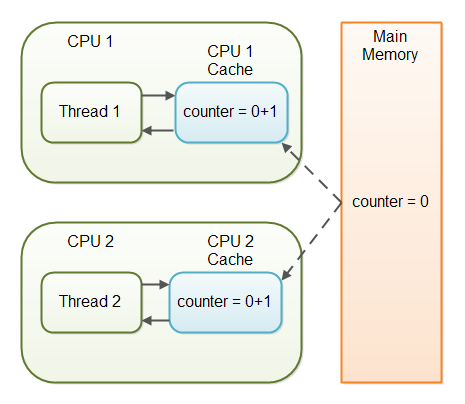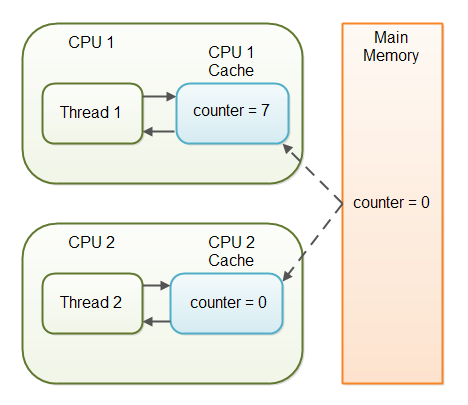转自:
http://tutorials.jenkov.com/java-concurrency/volatile.html
The Java volatile keyword is used to mark a Java variable as "being stored in main memory". More precisely that means, that every read of a volatile variable will be read from the computer's main memory, and not from the CPU cache, and that every write to a volatile variable will be written to main memory, and not just to the CPU cache.
Actually, since Java 5 the volatile keyword guarantees more than just that volatile variables are written to and read from main memory. I will explain that in the following sections.
The Java volatile Visibility Guarantee
The Java volatile keyword guarantees visibility of changes to variables across threads. This may sound a bit abstract, so let me elaborate.
In a multithreaded application where the threads operate on non-volatile variables, each thread may copy variables from main memory into a CPU cache while working on them, for performance reasons. If your computer contains more than one CPU, each thread may run on a different CPU. That means, that each thread may copy the variables into the CPU cache of different CPUs. This is illustrated here:

With non-volatile variables there are no guarantees about when the Java Virtual Machine (JVM) reads data from main memory into CPU caches, or writes data from CPU caches to main memory. This can cause several problems which I will explain in the following sections.
Imagine a situation in which two or more threads have access to a shared object which contains a counter variable declared like this:
public class SharedObject {
public int counter = 0;
} Imagine too, that only Thread 1 increments the counter variable, but both Thread 1 and Thread 2 may read the counter variable from time to time.
If the counter variable is not declared volatile there is no guarantee about when the value of the countervariable is written from the CPU cache back to main memory. This means, that the counter variable value in the CPU cache may not be the same as in main memory. This situation is illustrated here:
The problem with threads not seeing the latest value of a variable because it has not yet been written back to main memory by another thread, is called a "visibility" problem. The updates of one thread are not visible to other threads.
By declaring the counter variable volatile all writes to the counter variable will be written back to main memory immediately. Also, all reads of the counter variable will be read directly from main memory. Here is how the volatile declaration of the counter variable looks:
public class SharedObject {
public volatile int counter = 0;
} Declaring a variable volatile thus guarantees the visibility for other threads of writes to that variable.
The Java volatile Happens-Before Guarantee
Since Java 5 the volatile keyword guarantees more than just the reading from and writing to main memory of variables. Actually, the volatile keyword guarantees this:
- If Thread A writes to a volatile variable and Thread B subsequently reads the same volatile variable, then all variables visible to Thread A before writing the volatile variable, will also be visible to Thread B after it has read the volatile variable.
- The reading and writing instructions of volatile variables cannot be reordered by the JVM (the JVM may reorder instructions for performance reasons as long as the JVM detects no change in program behaviour from the reordering). Instructions before and after can be reordered, but the volatile read or write cannot be mixed with these instructions. Whatever instructions follow a read or write of a volatile variable are guaranteed to happen after the read or write.
These statements require a deeper explanation.
When a thread writes to a volatile variable, then not just the volatile variable itself is written to main memory. Also all other variables changed by the thread before writing to the volatile variable are also flushed to main memory. When a thread reads a volatile variable it will also read all other variables from main memory which were flushed to main memory together with the volatile variable.
Look at this example:
Thread A:
sharedObject.nonVolatile = 123;
sharedObject.counter = sharedObject.counter + 1;
Thread B:
int counter = sharedObject.counter;
int nonVolatile = sharedObject.nonVolatile; Since Thread A writes the non-volatile variable sharedObject.nonVolatile before writing to the volatilesharedObject.counter, then both sharedObject.nonVolatile and sharedObject.counter are written to main memory when Thread A writes to sharedObject.counter (the volatile variable).
Since Thread B starts by reading the volatile sharedObject.counter, then both the sharedObject.counterand sharedObject.nonVolatile are read from main memory into the CPU cache used by Thread B. By the time Thread B reads sharedObject.nonVolatile it will see the value written by Thread A.
Developers may use this extended visibility guarantee to optimize the visibility of variables between threads. Instead of declaring each and every variable volatile, only one or a few need be declaredvolatile. Here is an example of a simple Exchanger class written after that principle:
public class Exchanger {
private Object object = null;
private volatile hasNewObject = false;
public void put(Object newObject) {
while(hasNewObject) {
//wait - do not overwrite existing new object
}
object = newObject;
hasNewObject = true; //volatile write
}
public Object take(){
while(!hasNewObject){ //volatile read
//wait - don't take old object (or null)
}
Object obj = object;
hasNewObject = false; //volatile write
return obj;
}
} Thread A may be putting objects from time to time by calling put(). Thread B may take objects from time to time by calling take(). This Exchanger can work just fine using a volatile variable (without the use ofsynchronized blocks), as long as only Thread A calls put() and only Thread B calls take().
However, the JVM may reorder Java instructions to optimize performance, if the JVM can do so without changing the semantics of the reordered instructions. What would happen if the JVM switched the order of the reads and writes inside put() and take()? What if put() was really executed like this:
while(hasNewObject) {
//wait - do not overwrite existing new object
}
hasNewObject = true; //volatile write
object = newObject; Notice the write to the volatile variable hasNewObject is now executed before the new object is actually set. To the JVM this may look completely valid. The values of the two write instructions do not depend on each other.
However, reordering the instruction execution would harm the visibility of the object variable. First of all, Thread B might see hasNewObject set to true before Thread A has actually written a new value to theobject variable. Second, there is now not even a guarantee about when the new value written to objectwill be flushed back to main memory (well - the next time Thread A writes to a volatile variable somewhere...).
To prevent situations like the one described above from occurring, the volatile keyword comes with a "happens before guarantee". The happens before guarantee guarantees that read and write instructions of volatile variables cannot be reordered. Instructions before and after can be reordered, but the volatile read/write instruction cannot be reordered with any instruction occurring before or after it.
Look at this example:
sharedObject.nonVolatile1 = 123;
sharedObject.nonVolatile2 = 456;
sharedObject.nonVolatile3 = 789;
sharedObject.volatile = true; //a volatile variable
int someValue1 = sharedObject.nonVolatile4;
int someValue2 = sharedObject.nonVolatile5;
int someValue3 = sharedObject.nonVolatile6; The JVM may reorder the first 3 instructions, as long as all of them happens before the volatile write instruction (they must all be executed before the volatile write instruction).
Similarly, the JVM may reorder the last 3 instructions as long as the volatile write instruction happens before all of them. None of the last 3 instructions can be reordered to before the volatile write instruction.
That is basically the meaning of the Java volatile happens before guarantee.
volatile is Not Always Enough
Even if the volatile keyword guarantees that all reads of a volatile variable are read directly from main memory, and all writes to a volatile variable are written directly to main memory, there are still situations where it is not enough to declare a variable volatile.
In the situation explained earlier where only Thread 1 writes to the shared counter variable, declaring thecounter variable volatile is enough to make sure that Thread 2 always sees the latest written value.
In fact, multiple threads could even be writing to a shared volatile variable, and still have the correct value stored in main memory, if the new value written to the variable does not depend on its previous value. In other words, if a thread writing a value to the shared volatile variable does not first need to read its value to figure out its next value.
As soon as a thread needs to first read the value of a volatile variable, and based on that value generate a new value for the shared volatile variable, a volatile variable is no longer enough to guarantee correct visibility. The short time gap in between the reading of the volatile variable and the writing of its new value, creates an race condition where multiple threads might read the same value of the volatile variable, generate a new value for the variable, and when writing the value back to main memory - overwrite each other's values.
The situation where multiple threads are incrementing the same counter is exactly such a situation where a volatile variable is not enough. The following sections explain this case in more detail.
Imagine if Thread 1 reads a shared counter variable with the value 0 into its CPU cache, increment it to 1 and not write the changed value back into main memory. Thread 2 could then read the same countervariable from main memory where the value of the variable is still 0, into its own CPU cache. Thread 2 could then also increment the counter to 1, and also not write it back to main memory. This situation is illustrated in the diagram below:

Thread 1 and Thread 2 are now practically out of sync. The real value of the shared counter variable should have been 2, but each of the threads has the value 1 for the variable in their CPU caches, and in main memory the value is still 0. It is a mess! Even if the threads eventually write their value for the shared counter variable back to main memory, the value will be wrong.
When is volatile Enough?
As I have mentioned earlier, if two threads are both reading and writing to a shared variable, then using the volatile keyword for that is not enough. You need to use a synchronized in that case to guarantee that the reading and writing of the variable is atomic. Reading or writing a volatile variable does not block threads reading or writing. For this to happen you must use the synchronized keyword around critical sections.
As an alternative to a synchronized block you could also use one of the many atomic data types found in the java.util.concurrent package. For instance, the AtomicLong or AtomicReference or one of the others.
In case only one thread reads and writes the value of a volatile variable and other threads only read the variable, then the reading threads are guaranteed to see the latest value written to the volatile variable. Without making the variable volatile, this would not be guaranteed.
The volatile keyword is guaranteed to work on 32 bit and 64 variables.
Performance Considerations of volatile
Reading and writing of volatile variables causes the variable to be read or written to main memory. Reading from and writing to main memory is more expensive than accessing the CPU cache. Accessing volatile variables also prevent instruction reordering which is a normal performance enhancement technique. Thus, you should only use volatile variables when you really need to enforce visibility of variables.






















 1557
1557











 被折叠的 条评论
为什么被折叠?
被折叠的 条评论
为什么被折叠?








